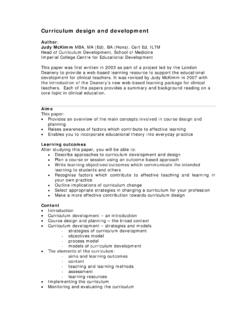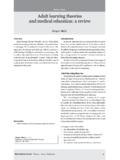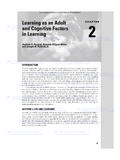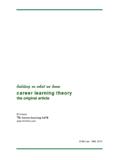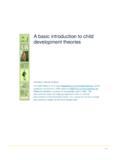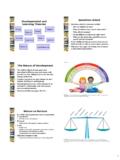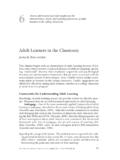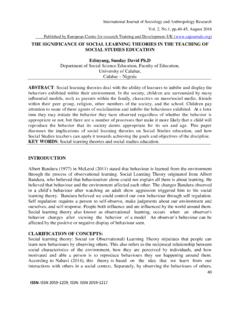Transcription of Learning theories - faculty.londondeanery.ac.uk
1 Learning theories Judy McKimm There has been a lot of research into the way people learn and certain theories have been influential on developments in all areas of education, but particularly in adult and higher education. Some of the key theories on Learning are described below. Domains of Learning Bloom s taxonomy (1956) of Learning objectives is often used which identifies three domains. cognitive (knowledge and intellectual skills) psychomotor (physical skills) affective (feelings and attitudes) Each of these domains is subdivided to form hierarchies of objectives of increasing complexity.
2 For example the cognitive domain has six levels, increasing in complexity: knowledge (recognition and recall of information) comprehension (understanding or translating information) application (uses information in a new context) analysis (separates into parts to reveal new relationships) synthesis (combines elements to create a new situation) evaluation (involves judgement or decision making) Newble and Cannon (1994) suggest that for practical purposes when developing Learning objectives the six domains are collapsed into three general subdivisions: recall of information understanding problem solving Skills objectives are usually written in terms of competence.
3 The psychomotor domain has five levels: imitation (observes skill and tries to reproduce it) proportion) with harmony pletes skilful tasks competently and automatically) Attitudinal objectives are the most difficult to write because they really se to stimuli) without (shows commitment to a set of values by behaviour) manipulation (performs skill from instruction) precision (reproduces skill with accuracy and articulation (combines one or more skills in sequence and consistency) naturalisation (comdescribe observable behaviour. The affective domain has five levels: receiving (aware of external stimuli eg.
4 Listening) responding (complies with expectations in respon valuing (displays behaviour consistent with a single belief coercion) organising characterising (behaviour consistent with a value system) Judy McKimm, Dec 02 1 Learning cycles and Learning styles olb was also influential in describing how Learning takes place. His Learning Kcycle, see below, approaches the idea of Learning as experiential ( Learning by doing). Experiential Learning is highly relevant to Learning in medicine and healthcare and Kolb suggests that ideas are not fixed, but are formed and modified through the experiences we have and by our past experience.
5 These concepts underpin prevailing ideas in medical and other professional education and training such as the reflective practitioner and the shift from novice to expert . he Learning cycle requires four kinds of abilities/ Learning contexts: d to become must be available for learners to be able to learners must be able to form and process le to use theories to solve or effanning the curriculum Wolf and Kolb (1984) suggested that lea T concrete experience learners are enabled and encourageinvolved in new experiences reflective observation time reflect on their experience from different perspectives, constructive feedback is important here abstract conceptualisation ideas and integrate them into logical theories active experimentation learners need to be abproblems and make decisions and test theories in new situations, this takes learners back to the start of the cycle again.
6 Ective Learning to occur, it is important that those plFinclude opportunities for these Learning contexts and abilities to occur. rners develop different Learning styles that emphasise preference for some modes of Learning over others. The styles are shown in the diagram below, they are placed between the two Learning abilities seen to be dominant for that Learning style eg. a convergent learningstyle is seen to have abstract conceptualisation and active experimentation asthe dominant Learning abilities. Judy McKimm, Dec 02 2 Converger - applies ideas in a practical way es ideas nse of disparate ew Diverger has good imagination and generat Assimilator creates theoretical models and makes seobservations Accommodator carries out plans and tasks that involve them in nexperiences Other work which developed the ideas of Learning styles and which has been ctivist respond most positively to Learning situations that offer challenge and respond most positively to logical, rational structure and clear aims.
7 He diagram below plots the two theories together. There are a number of ) se widely used is that of Honey and Mumford (1982). They suggest that there arefour types of learner: Awhich include new experiences and problems Reflector respond most positively to structured Learning activities in which time is provided to think, reflect and observe. They like to work in a detailed manner Theorist -They need time to explore ideas and opportunity to question and stretch their intellect Pragmatist - respond most positively to practically-based immediately relevantlearning activities which allow them to practice and use theory Tquestionnaires available (eg.
8 Honey and Mumford, Entwistle and Ramsdenwhich aim to define learners preferred Learning styles. These are of limited ufor teachers, but can help students to identify and think about their preferred Learning style and whether they might modify their behaviour. Judy McKimm, Dec 02 3 Approaches to Learning and studying Other research (eg. Biggs, 1987) has categorised different approaches to Learning . Biggs research views Learning as having five levels, three which indicate a surface approach to Learning : an increase in knowledge memorising the acquisition of procedures and two which indicate a deep approach to Learning : the abstraction of meaning understanding reality Students who adopt a deep approach to Learning are interested in Learning for its own sake, they want to understand ideas for themselves and learn by transforming.
9 They tend to: relate ideas to previous knowledge and experience look for patterns and underlying principles be actively involved and interested in course content adopt an evidence based approach critically examine arguments Students who adopt a surface approach to Learning often want merely to get through a course and learn by reproducing. They tend to: study without reflecting on purpose or strategy memorise facts and procedures by rote treat the course as unrelated sets of knowledge concepts In addition, a strategic approach to Learning has been identified (eg. have difficulty in making sense of new ideas and feel pressured about the amount of work involved Entwistle, 1998).
10 This describes students who want to achieve high grades Judy McKimm, Dec 02 4and pass the course, rather than who are interested in the intrinsic value of Learning , they learn by organising. The strategic approach is categorised by students who: put consistent but focussed effort into studying seek out the right conditions and materials for Learning manage time well are aware of assessment requirements and direct their Learning towards them try to work in a way that they perceive teachers want When we understand better how our students are Learning or approaching studying, we can design courses which best meet their needs and which encourage the types of Learning appropriate to medicine.

